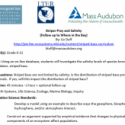
View The Resource
http://pie-lter.ecosystems.mbl.edu/sites/default/files/Where_in_the_Bay_Lesson_v02.pdf
http://pie-lter.ecosystems.mbl.edu/sites/default/files/Where_in_the_Bay_Lesson_v02.pdf
Time Required
2 hours
2 hours
Teaching Tips
Teacher may want to review the previous lesson for background necessary to prep students. The teacher may also need to run through the lesson and understand the NOAA database clearly before launching into the activity with students or do part of the lesson using a projector.
Teacher may want to review the previous lesson for background necessary to prep students. The teacher may also need to run through the lesson and understand the NOAA database clearly before launching into the activity with students or do part of the lesson using a projector.
About The Science
Activity is two separate activities: the first being a simplistic mapping of various species of prey of striped bass in Plum island Sound. Salinity data for Plum Island Sound is from 1987 and might need to be updated by the educator. Second activity takes students to NOAA's Estuarine Living Marine Resources ELMR database to search for fish species in different estuaries. Credits and references included in the body of the text for the authors of the NOAA database.
Activity is two separate activities: the first being a simplistic mapping of various species of prey of striped bass in Plum island Sound. Salinity data for Plum Island Sound is from 1987 and might need to be updated by the educator. Second activity takes students to NOAA's Estuarine Living Marine Resources ELMR database to search for fish species in different estuaries. Credits and references included in the body of the text for the authors of the NOAA database.
Pedagogy Annotation
Lesson would be best divided into two separate lessons with the first activity being very simplistic and more appropriate for elementary level students and the second activity more appropriate for middle school students. This lesson is part of a module. Therefore more background information can be found in the "Where in the Bay" lesson and it is assumed that students have retained that info for this lesson. As a stand-alone lesson teachers would need to provide some background information. Once the data has been analyzed, students are asked to formulate an additional question that can be answered using their data. This is the vehicle for asking questions or seeking further information piece. Lesson is written well but physical layout is challenging to follow. Strength is that it uses a NOAA database.
Lesson would be best divided into two separate lessons with the first activity being very simplistic and more appropriate for elementary level students and the second activity more appropriate for middle school students. This lesson is part of a module. Therefore more background information can be found in the "Where in the Bay" lesson and it is assumed that students have retained that info for this lesson. As a stand-alone lesson teachers would need to provide some background information. Once the data has been analyzed, students are asked to formulate an additional question that can be answered using their data. This is the vehicle for asking questions or seeking further information piece. Lesson is written well but physical layout is challenging to follow. Strength is that it uses a NOAA database.
Technical Details/Ease of Use
Educator should be familiar with access to and use of national database of the Estuarine Living Marine Resources.
Educator should be familiar with access to and use of national database of the Estuarine Living Marine Resources.










